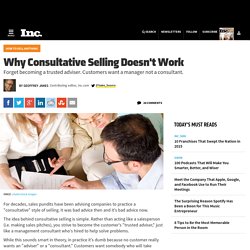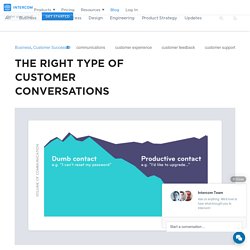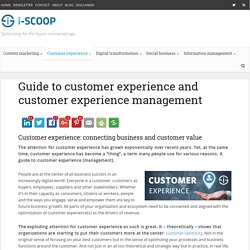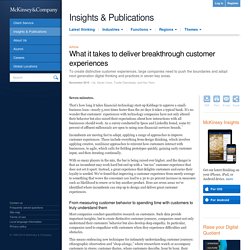

4 Keys to Customer Loyalty. Why Consultative Selling Doesn't Work. For decades, sales pundits have been advising companies to practice a "consultative" style of selling.

It was bad advice then and it's bad advice now. The idea behind consultative selling is simple. Rather than acting like a salesperson (i.e. making sales pitches), you strive to become the customer's "trusted adviser," just like a management consultant who's hired to help solve problems. While this sounds smart in theory, in practice it's dumb because no customer really wants an "adviser" or a "consultant. " Customers want somebody who will take responsibility for a crucial part of their business, not some smart**s who kibbitzes from the sidelines. Consider: everything a company buys from another company, it could decide to do itself. The same is true with smaller firms.
Customers want YOU--as the representative of your firm--to be personally responsible for making certain that a crucial job gets done. That's an important distinction. The Right Type of Customer Conversations. Conversations with customers are valuable, but they have to be the right type of conversations – not merely questions about forgotten passwords and the like.

They have to add value, for you, and them. Good Conversation, Good Customer In Intercom, we encourage businesses to talk to their customers. It’s how you grow a business; it’s how you keep customers happy, loyal, and evangelical about your product. But talking to your customers isn’t about blindly spitting out messages to everyone, or counting every customer contact as a ‘good thing’.
Let’s talk about Internet Scale. You can’t talk to everyone about everything If you have 1,000,000 monthly active users, and 0.1% contact you each day, you have 1,000 contacts to deal with every day. Eliminating Dumb Contacts Most web companies are on the defensive. To reduce your volume, you have to reduce your dumb contacts.
For each type of contact, there’s an appropriate action you should follow… Prioritising Your Work. Guide to customer experience and customer experience management. Customer experience management: value is in the eyes of the beholder So, the term “customer experience management” (CEM) –literally managing customer experiences – might seem somewhat of a weird term at first sight and maybe even out of touch with a changing reality.

Sure, you can manage many elements that create the conditions for fantastic customer experiences: the quality of your customer service, the response speed of your contact center representatives, the content you create, the quality of the various inbound and outbound interactions (not in a marketing context but a general context of inbound and outbound communications), the brand narrative, the touchpoints where different interactions occur, the overall “ambience” of physical experiences, deep insight into what customers want, the list goes on and will grow. However, you cannot really “manage” the customer experience as such.
And the reason is simply: customers shape their own experiences. So, what can you do? What it takes to deliver breakthrough customer experiences. Seven minutes.

That’s how long it takes financial-technology start-up Kabbage to approve a small-business loan—nearly 5,000 times faster than the 20 days it takes a typical bank. It’s no wonder that customers’ experiences with technology companies have not only altered their behavior but also raised their expectations about how interactions with all businesses should work. As a survey conducted by Ipsos and LinkedIn found, some 67 percent of affluent millennials are open to using non-financial-services brands. Incumbents are moving fast to adapt, applying a range of approaches to improve customer experiences. These include everything from design thinking, which involves applying creative, nonlinear approaches to reinvent how customers interact with businesses, to agile, which calls for fielding prototypes quickly, gaining early customer input, and then iterating continually.